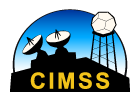On 19 September 2016 a pyroCb formed northwest of Lake Baikal in eastern Russia. Himawari-8 detected the smoke plumes and pyroCb cloud, as well as the fire hot spots. The pyroCb cloud (~57.4º N, 105.3ºE) formed around 8:20 UTC . Starting at 7:30 UTC on 19 September, the animation below (also available as an MP4) shows Himawari-8 0.63 µm visible (left) and 3.9 µm shortwave IR (right) . In the shortwave IR images, the red pixels indicate very hot IR brightness temperatures exhibited by the fire source regions.

HIMAWARI-8 0.63 µm visible channel (left) and 3.9 µm shortwave IR channel images (right) (click to play animation)
In addition, using Himawari-8 10.4 μm IR channel the cloud-top IR brightness temperature could be found. The animation below, starting at 8:00 UTC on 19 September, shows the brightness temperature for the pyroCb cloud reached -36.9ºC at 9:10 UTC (green color enhancement).
A slightly longer animation — covering the period from 06:00 to 09:20 UTC — of Himawari-8 Visible (0.64 μm), Shortwave Infrared (3.9 μm) and Infrared Window (10.4 μm) images is shown below. The pyroCb cloud formed near the center of the images, and the cold anvil of the cloud then moved rapidly northeastward.
Himawari-8 Visible (top), Shortwave Infrared (middle) and Infrared Window (bottom) images [click to play animation]
![Metop-B AVHRR Shortwave Infrared (left) and Longwave Infrared (right) images at 12:12 UTC [click to enlarge]](http://pyrocb.ssec.wisc.edu/wp-content/uploads/2016/09/160919_1212utc_metop2_shortwaveIR_longwaveIR_pyrocb_Russia.jpg)
Metop-B AVHRR Shortwave Infrared (left) and Longwave Infrared (right) images at 12:12 UTC [click to enlarge]
A close-up view of the dense smoke pall on 19 September — which was entrained into the circulation of a compact middle-tropospheric (500 hPa) low pressure / enhanced vorticity lobe that was passing over the area of active fires — as seen on a Suomi NPP VIIRS true-color image (with VIIRS-detected fire hot spots in red) is shown below. There was also a compact 500 hPa cold pool of -20º C associated with this low/vorticity feature, which help to destabilize the atmosphere making the environment more conducive to pyroCb development.
A sequence of daily VIIRS true-color images during the 13-18 September period showed the increase in areal coverage of smoke across that region as fire activity ramped up (below).


![Suomi NPP VIIRS true-color image + VIIRS-detected fire hot spots [click to enlarge]](http://pyrocb.ssec.wisc.edu/wp-content/uploads/2016/09/160919_viirs_truecolor_hot_spots_fires_Russia_anim.gif)
![Suomi NPP VIIRS true-color images during the 13-18 September period [click to enlarge]](http://pyrocb.ssec.wisc.edu/wp-content/uploads/2016/09/160913-18_suomi_npp_viirs_truecolor_wildfire_smoke_Russia_anim.gif)